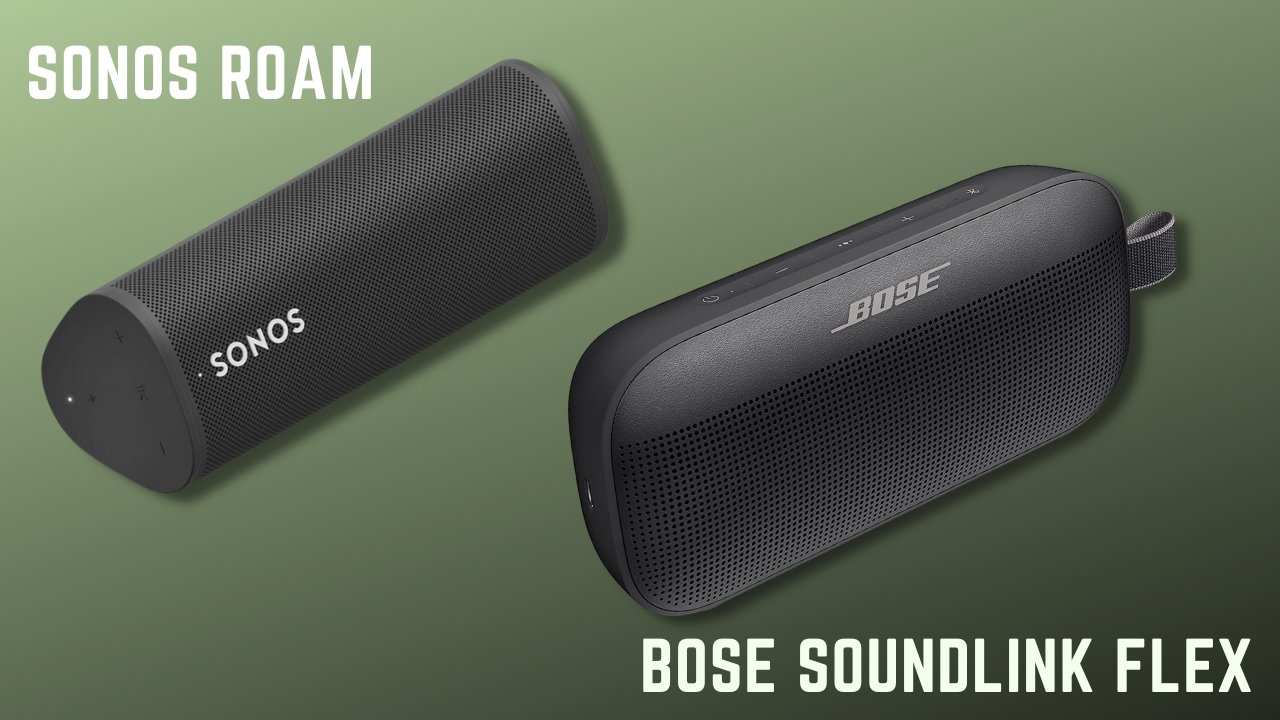
When it comes to portable speakers, you typically have two options: a powerful speaker with impressive sound performance that has a bulkier form factor and heavier design or a more portable option that makes some sound performance sacrifices. Well, I’ve got the speakers that may finally bring the best of both, so the Roam was announced in march with a launch date set for the 20th of April 2021.
With a retail price of $179, it is Sonos’s smallest and most affordable speaker. It’s also their most portable speaker with wi-fi and Bluetooth, allowing you to connect to your Sonos ecosystem when you’re at home with control over wi-fi and switch to Bluetooth when you’re out and about, much like how the Sonos Move works but at a smaller size and less expensive price point.
The new Bose portable speaker, the Bose Soundlink Flex, is also in my possession. This is Bose’s newest portable speaker, which sits below their larger and more expensive Revolve speaker and above their smaller Bose Soundlink Micro and Soundlink Color 2. The Bose Soundlink Flex has an RRP of $149.95, which is okay compared to the portable speakers market.
| Sonos Roam | Bose SoundLink Flex |
 |  |
| BUY NOW | BUY NOW |
| PROS | PROS |
| + Mic mute button. + Excellent far-field performance. + IP67 rating for dust and water resistance. + Bluetooth and Wi-Fi compatibility. | + IP67 rating for dust and water resistance. + Outstandingly portable. + Excellent far-field performance. + Good performance with dialogue. |
| CONS | CONS |
| – Doesn’t get very loud. – 5.1-hour battery life. – Lacks some low-bass. | – Voice assistants aren’t built-in. – No graphic EQ or presets. – Compression at max volume. |
Sonos Roam vs Bose SoundLink Flex: Specs
| Categories | Sonos Roam | Bose SoundLink Flex |
| Weather Resistance | Dust-proof/Waterproof (IP67) | Dust-proof/Waterproof (IP67) |
| Built-in Battery | Y (10 hrs) | Y (12 hours) |
| USB | No | No |
| Headphone Jack | No | No |
| Bluetooth Version | 5.0 | 4.2 |
| Hands-free Calling | No | Yes |
| Apple AirPlay | AirPlay 2 | No |
| Stereo Pairing | Yes | Yes |
| Alexa | Yes | Yes |
| Google Assistant | Yes | Yes |
| Weight | 0.43 kilograms | 0.6 kilograms |
| Charging port | USB-C | USB-C |
Sonos Roam vs Bose SoundLink Flex: Design
Now, check out the Sonos Roam and the JBL Flip Six to see that bows still need to adopt the popular cylindrical design many other companies are currently choosing. However, the Bose Soundlink Flex is very different from the shape and style of these initially. I wasn’t sold on this form factor when I first saw it online, but I’ve changed my mind after holding it in my hands.
I like that it’s different from these other speakers because it gives it a unique flair. More importantly, the design is functional, though it’s more challenging to handle than generally cylindrical speakers.

As a result, you can lay it flat, stand it upright, or hang it from something using the small tab that allows you to attach a carabiner to your bag or other objects. Its dimensions are about average for a portable speaker and are comparable to the ones I’ve already shown you. Dimensionally, it measures:
- 9 cm high
- 20.1 cm wide
- 5.2 cm deep
- Weighs 0.6 Kg
Since the Sonos Roam also comes with dimensions of:
- 6.61 inches tall
- 2.44 inches wide
- 2.36 inches deep
- Weighing 0.43 Kg
It gives you the confidence to throw it around a bit, and I wouldn’t freak out if I dropped the Roam like I did with the Move. We all remarked on how small and light it was when we first got our hands on it. However, this means you would be holding it only some of the time. I can imagine taking it camping, on short day trips, or some other activity.
It comfortably fits in the palm of your hand. Many portable speakers have cylindrical shapes, but Sonos chose a rounded, pyramid-like shape instead. This was done on purpose so that it could be stable on various surfaces, and what I like about it is that when you lay it flat, the speakers will angle upwards toward your head if you have it on the floor.

The rubberized top and bottom also prevent the device from rolling around on some surfaces. I’m also glad that the top panel controls are actual recessed rubber buttons rather than inset touch controls because that prevents you from accidentally touching a button when you pick up the device or carry it in a bag, among other things. However, it does require you to press the buttons a little harder.
Sonos Roam vs Bose SoundLink Flex: Durability
The Bose Soundlink Flex and the Sonos Roam are both ip67 rated, which means you can submerge them for up to 30 meters for 30 minutes. They are both dust and moisture-resistant. I was playing around with this one at the pool with my daughter, and it sounded great.

If you use the Bose Soundlink Flex underwater, the audio will stop, but only because the Bluetooth connection is lost. As soon as you return, it re-establishes its connection with your phone. It remains connected, but as soon as you press the play button on your phone, the music starts playing, which is fantastic.
Sonos Roam vs Bose SoundLink Flex: Features
Let’s discuss some of the similarities and differences. First of all, both of these speakers are Bluetooth ones. However, the Sonos Roam is a wireless speaker supporting AirPlay 2. Numerous features of the Sonos Roam are only available when the device is connected to wi-fi; when using Bluetooth, some of these features are, in fact, inaccessible.

The Sonos Roam has Bluetooth 5.0, while the Bose Soundlink Flex has Bluetooth 4.2, according to my research, because I wasn’t sure. However, 4.2 is the lowest Bluetooth standard you can have and still stream lossless audio or high-resolution content to a Bluetooth device.
So you’re covered in terms of sound quality, but the main difference between those two is the maximum distance your device or whatever is connected to the Bose Soundlink Flex can be from it. You know, typically it’s what 30 feet now, I’m not going to be longer than 30 feet away from this device, or my phone won’t be, my iPad won’t be, or whatever, so I don’t think that that’s a concern, so it’s pretty much the same.
Sonos wanted to ensure that switching between wi-fi and Bluetooth was seamless, so the roam would automatically connect to wi-fi when it’s in range and switch to Bluetooth if it’s out of range. This is the first feature to highlight.

Holding the play/pause button on the Sonos roam allows you to instantly send the audio to the closest Sonos speaker to you at that moment. This new feature, only available on the roam, makes the transition from the outdoors to the interior of a building even more seamless.
Sonos Roam vs Bose SoundLink Flex: Extra Features
Now that the microphone can also be used as a speakerphone, you can receive and take your call through Bose Soundlink Flex if one comes in, which the Sonos Roam doesn’t have.

The Sonos Roam does have a microphone, but it’s not used for making calls; instead, it’s used for two other things. First, you can assign your assistants to the Sonos Roam, such as Google or Alexa, but that only works on wi-fi rather than Bluetooth. Second, the Sonos Roam has a feature called AutomaticTrueplay that uses the speaker’s position to determine whether it’s standing, sitting, or in a different room than it was before.
However, the Bose Soundlink Flex has something called Position IQ, and I’m not sure if it actually works or even has any significance. Position IQ is supposed to allow your speaker not to change its sound or to optimize the sound based on how it is resting, so if it is vertical, horizontal, or flat on its back, for example,

The only thing I can tell is that when the Bose Soundlink Flex is lying flat on its back, I can tell that the sound is firing up, but that’s it instead of like at me if it’s facing forward. Position IQ will make it so that the sound doesn’t change that much, and I can’t tell the difference. Many people on Youtube and online have said they can’t hear it, and neither can I.
Sonos Roam vs Bose SoundLink Flex: Sound Quality
And if we’re talking about sound, we should start with the bass because it surprises me the most. The Bose Soundlink Flex speaker can produce so much bass. Now, the bass isn’t loud, intrusive, muddy, or anything else; instead, it’s rich, complete, and sounds fantastic. In addition, the mids are excellent, the vocals are crystal clear, and the highs are well-balanced.

The Roam’s audio system has two class H amplifiers that drive a mid-woofer for mid-range and lower frequencies and a tweeter for vocals. To give you the broadest sound stage for the size of the speaker, Sonos has placed the drivers as close to the speaker’s edges as possible. If you’re familiar with Sonos speakers, the Roam offers that same signature sound on a smaller scale, with crisp vocals, a warm midrange, and a tight bass.
Sonos Roam vs Bose SoundLink Flex: Audio Performance

However, the Bose SoundLink Flex speaker is tuned so well that you won’t need that. I will say this: if you hear the speaker and think, “Man, I don’t like the way it sounds,” then you’re not going to like the way it sounds. If you’re the type who likes EQ stuff, then you should at least give yourself a chance to adjust it.
The speaker does not distort; you can turn it up to 100% without feeling like something is off. Since it’s still a small portable Bluetooth speaker, it doesn’t sound its best at 100%, but between 75% and 80% is where I’ll outplay it because it starts to lose some of its charms at that point. However, at 80%, it’s knocking this thing out of the park.

The Sonos Roam will use its microphones to detect and automatically adjust its acoustics to suit its environment wherever you are, and in our testing, it works well. This feature also works on both wifi and Bluetooth. AutoTrueplay is another handy feature carried over from the Sonos Move speaker. Now that Sonos Roam will adjust the EQ based on both horizontal and vertical orientations, I like that feature.
Sonos Roam vs Bose SoundLink Flex: Battery Life & Charging
The Bose Soundlink Flex also offers 12 hours of battery life compared to the Sonos Roam’s 10. However, it’s not that bad, with 12 hours of battery life. I mean, if you’re running this at 80% or so, I’ve gotten about 9-10 hours with this, so this is about true. It’s also much louder than the Sonos Roam when connected via Bluetooth or Wi-Fi; this is a much louder speaker.

The Bose Soundlink Flex charges via USB-C in about 4 hours, but the Sonos Roam charges in a little less time and has a slightly shorter battery life, so that’s another factor to consider. The Sonos Roam also has a USB-C port for charging, which is interestingly situated at a right angle and is reportedly the first time a speaker has ever used a right-angle USB-C port. Additionally, it has an auto sleep mode that aids battery conservation when not used.
If you’re looking for a matching option, Sonos offers a compatible Qi charger available in shadow black or white, has a magnetic base to connect to your speaker, and costs $30 at the list price.
Final Thoughts
The Roam’s full integration with your Sonos system is its best feature. I look forward to using this as an extra speaker in my home to use in the kitchen, bathroom, garden, etc., and then taking it out and about to the beach, park, and on vacation.
The Bose Soundlink Flex is a fantastic speaker, and if you’re having a small gathering with only 10 or so people, you could probably get away with using these speakers as your sole speakers. I am curious if I would use this speaker to host a cookout or a medium-sized to large-sized party, but it’s cool that it can come close to doing so, and the sound it produces is fantastic for a speaker of this size.




